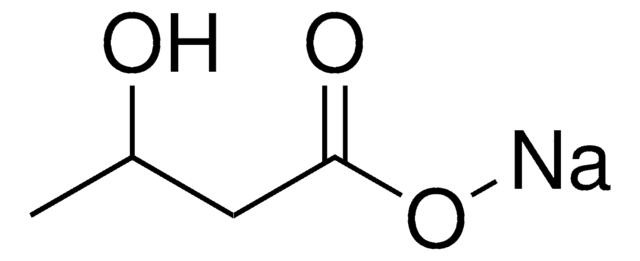2854
Ethylenediaminetetraacetic acid disodium salt solution
2%, solution
Synonym(s):
(Ethylenedinitrilo)tetraacetic acid disodium salt, EDTA disodium salt, EDTA-Na2
Sign Into View Organizational & Contract Pricing
All Photos(1)
About This Item
Linear Formula:
[-CH2N(CH2CO2Na)CH2CO2H]2
CAS Number:
Molecular Weight:
336.21
Beilstein:
3822669
MDL number:
UNSPSC Code:
12352107
PubChem Substance ID:
NACRES:
NA.77
Recommended Products
form
solution
concentration
2%
storage temp.
2-8°C
SMILES string
[Na+].[Na+].OC(=O)CN(CCN(CC(O)=O)CC([O-])=O)CC([O-])=O
InChI
1S/C10H16N2O8.2Na/c13-7(14)3-11(4-8(15)16)1-2-12(5-9(17)18)6-10(19)20;;/h1-6H2,(H,13,14)(H,15,16)(H,17,18)(H,19,20);;/q;2*+1/p-2
InChI key
ZGTMUACCHSMWAC-UHFFFAOYSA-L
Looking for similar products? Visit Product Comparison Guide
General description
Ethylenediamine tetraacetate (EDTA) is a calcium ion chelator, that has a low molecular mass of 292.24 Da.
Application
- Dual-Responsive Hydrogels for Mercury Ion Detection and Removal from Wastewater.: This study discusses the application of ethylenediaminetetraacetic acid disodium salt in the development of dual-responsive hydrogels, highlighting its effectiveness in detecting and removing mercury ions from wastewater (Diacon et al., 2024).
- Photocatalytic Hydrogen Evolution Activity of Nitrogen/Fluorine-Codoped Rutile TiO(2).: The article explores the role of ethylenediaminetetraacetic acid disodium salt in enhancing the photocatalytic activity of nitrogen/fluorine-codoped rutile TiO(2) for hydrogen evolution (Miyoshi et al., 2023).
- High-efficiency cleaning technology and lifespan prediction for the ceramic membrane treating secondary treated effluent.: This study presents a novel cleaning technology involving ethylenediaminetetraacetic acid disodium salt for ceramic membranes, offering insights into efficiency enhancements and lifespan predictions (Lv et al., 2023).
- Reversible Morphology Locking via Metal Infiltration in a Block Copolymer.: This research investigates the reversible morphology locking of block copolymers facilitated by metal infiltration, using ethylenediaminetetraacetic acid disodium salt as a key component in the process (Ma et al., 2023).
Biochem/physiol Actions
Ethylenediaminetetraacetic acid disodium salt has the ability to block the binding of vasoactive intestinal peptide to macrophage membranes. It is mainly used in the purification of protein, to remove divalent cations and also to prevent protease activity.
Storage Class Code
12 - Non Combustible Liquids
WGK
WGK 1
Flash Point(F)
Not applicable
Flash Point(C)
Not applicable
Choose from one of the most recent versions:
Already Own This Product?
Find documentation for the products that you have recently purchased in the Document Library.
Customers Also Viewed
J J Segura et al.
Journal of endodontics, 22(7), 337-340 (1996-07-01)
The purpose of this study was to investigate the effect of the disodium salt of ethylenediamine tetraacetate (EDTA), a calcium ion chelator used in the root canal therapy, on vasoactive intestinal peptide (VIP) binding to macrophage membranes (MM's). Binding assays
Drawbacks of dialysis procedures for removal of EDTA
Monico A, et al.
PLoS ONE, 12(1), e0169843-e0169843 (2017)
Rebecca Wüst et al.
Frontiers in bioengineering and biotechnology, 10, 964705-964705 (2022-10-11)
Vascularization of tissue-engineered constructs remains a key challenge in the field of skeletal muscle tissue engineering. One strategy for vascularizing organoids is in vitro pre-vascularization, relying on de novo assembly of undifferentiated endothelial cells into capillaries, a process termed vasculogenesis.
Suli Huang et al.
PloS one, 10(2), e0117007-e0117007 (2015-02-07)
microRNA (miRNA) plays a role in the pathogenesis of ischemic stroke, and single nucleotide polymorphisms in miRNA genes may contribute to disease susceptibility. However, the effect of miR-146a, miR-196a2, and miR-499 polymorphisms on ischemic stroke susceptibility has been rarely reported.
Sabrina Lusvarghi et al.
Nucleic acids research, 41(13), 6637-6649 (2013-05-04)
Interaction between the viral protein Rev and the RNA motifs known as Rev response elements (RREs) is required for transport of unspliced and partially spliced human immunodeficiency virus (HIV)-1 and HIV-2 RNAs from the nucleus to the cytoplasm during the
Our team of scientists has experience in all areas of research including Life Science, Material Science, Chemical Synthesis, Chromatography, Analytical and many others.
Contact Technical Service



